Find Bashan's secrets and its biblical significance on a map, unveiling a story that bridges ancient landscapes with enduring mysteries.
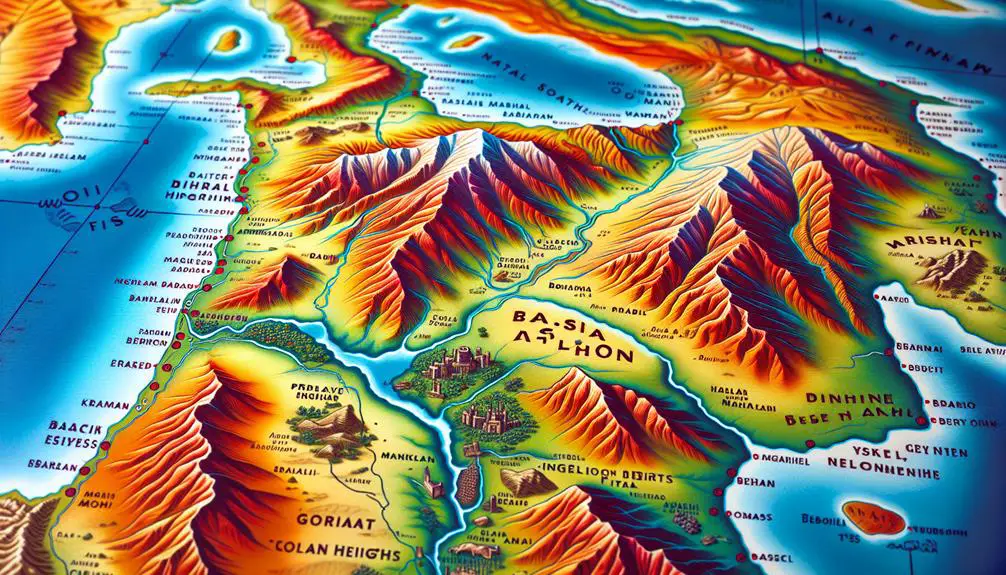
Bashan in the Bible Map
Imagine unrolling an ancient scroll, and there you find Bashan, a jewel in the crown of biblical geography. You might wonder about its boundaries, etched between the Golan Heights and the Yarmouk River, and why this region holds such a pivotal role in biblical narratives.
Bashan's story is not just one of ancient cities and forgotten battles, but a tapestry woven with cultural and theological threads that have influenced generations. As you stand on the brink of exploring Bashan's historical overview, geographical limits, and its indelible mark on both past and present cultures, consider how its echoes resonate in today's world.
Key Takeaways
- Bashan's geographical extent ranged from Mount Hermon to the Syrian desert, bordered by the Jordan River and Jabbok River.
- The region is historically and biblically significant, known for its fertile lands, ancient cities like Ashtaroth and Edrei, and as the land of giants.
- King Og's defeat in Bashan symbolizes divine intervention, marking the area as a key site of biblical narratives and spiritual warfare.
- Modern-day areas with historical ties to Bashan include the Golan Heights, Southern Syria, Northern Jordan, and Northeastern Israel, enriching contemporary religious interpretations.
Historical Overview of Bashan
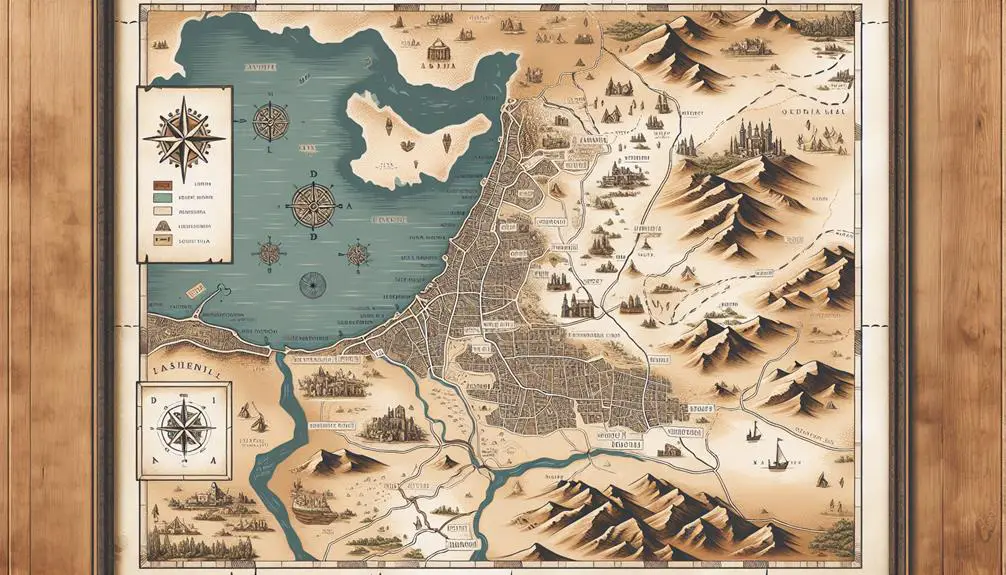
Bashan, an ancient region mentioned extensively in biblical texts, holds a significant place in the historical and cultural narratives of the Near East. You'd find its significance not only in the religious context but also in understanding the ancient economy and tribal affiliations that shaped the region's history.
Delving into Bashan's past, you encounter a complex tapestry of economic activities and societal structures that were pivotal to its standing among neighboring regions.
The ancient economy of Bashan was notably diverse, with agriculture, livestock, and trade playing central roles. Its fertile lands were renowned for supporting vast herds of cattle, a detail frequently highlighted in historical records, which underscores the region's agricultural affluence. You'd appreciate that Bashan's economic prosperity wasn't solely due to its natural resources but also to the ingenuity and organization of its inhabitants. Their ability to cultivate and manage these resources effectively set a foundation for a thriving economy.
Moreover, tribal affiliations in Bashan played a critical role in its social and political landscape. These affiliations weren't just markers of identity; they were intricate networks of alliances and enmities that influenced everything from land ownership to military strategies. Understanding these tribal dynamics is crucial for grasping the region's historical significance. They were the fabric of society in Bashan, shaping its culture, governance, and interactions with neighboring territories.
In analyzing Bashan's historical overview, it's clear that the ancient economy and tribal affiliations are indispensable themes. They provide insights into the region's resilience and adaptability, reflecting a rich heritage that continues to captivate scholars and enthusiasts alike.
Geographical Boundaries
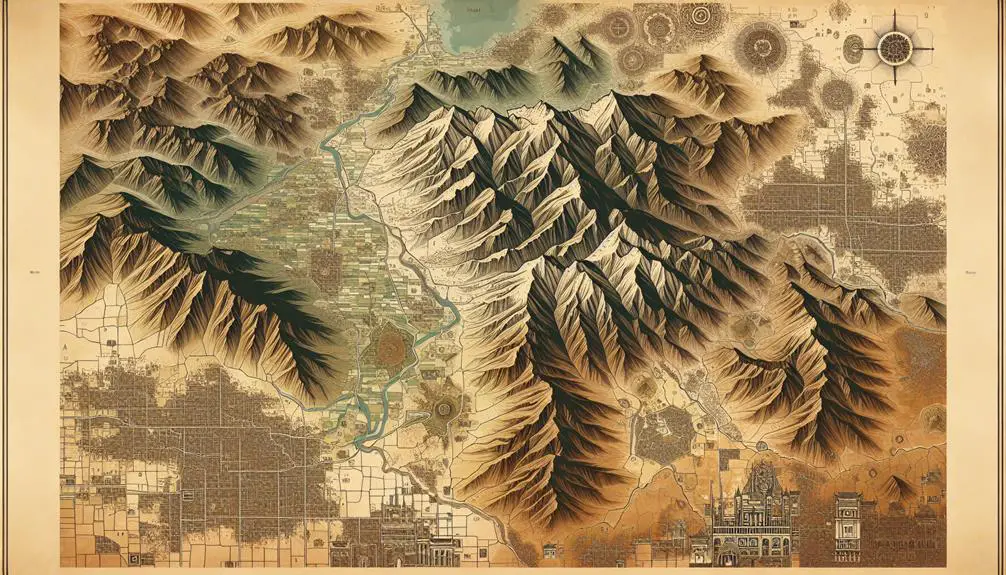
Understanding the historical and cultural significance of Bashan inevitably leads one to explore its geographical boundaries, which played a pivotal role in shaping the region's economic and social dynamics. Bashan's borders, marked by natural barriers and ancient demarcations, were often the center of border disputes that influenced political alliances and territorial control throughout history. These disputes weren't only about land but also about the control of trade routes that passed through Bashan, contributing to its economic importance in the ancient Near East.
The region's northern boundary traditionally extended to Mount Hermon, serving as a natural fortress against invaders and influencing the regional climate by capturing moisture from the Mediterranean. This climatic effect made Bashan fertile, renowned for its bountiful crops and lush pastures, which were essential for the sustenance and wealth of its inhabitants. To the west, the Jordan River delineated Bashan from the land of Gilead, creating a vital water source but also a contentious border that various groups sought to control.
To the east, Bashan stretched into the Syrian desert, its boundaries here more fluid, affected by the shifting sands and the political fortunes of neighboring tribes and empires. The southern border, often contested, ran close to the Jabbok River, marking the limit against the Moabite territories.
These geographical boundaries, marked by natural features and the scars of ancient conflicts, shaped the identity of Bashan. They influenced its regional climate, making it a land of agricultural abundance and strategic importance, forever etched in the annals of history and memory.
Biblical Significance
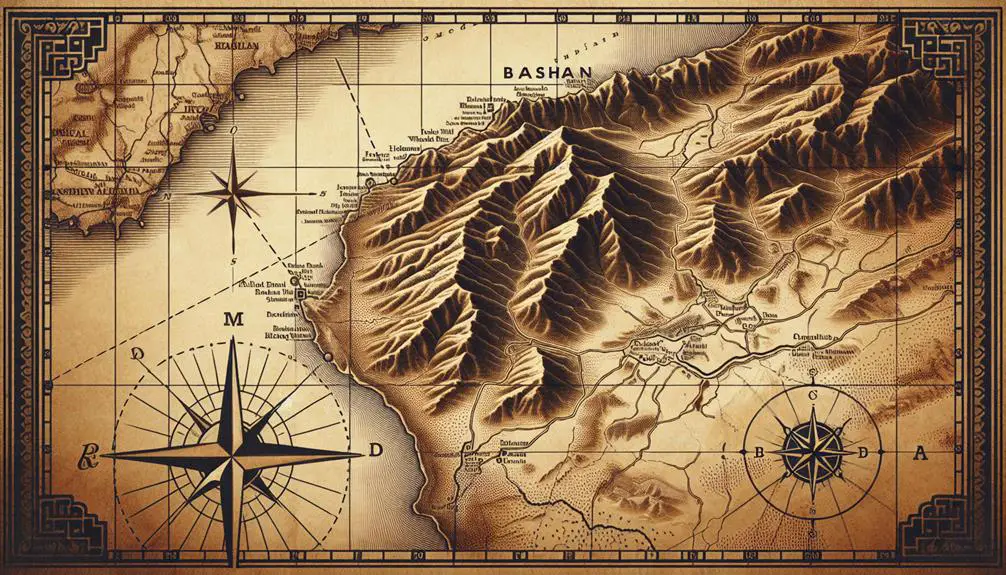
You'll find that Bashan's biblical significance is deeply rooted in its depiction as a land of giants, a narrative highlighted by the defeat of King Og.
This region's fertile pastures aren't merely geographical features but are emblematic of the heritage and prosperity promised to the Israelites.
Analyzing these elements reveals how Bashan's historical and theological dimensions intertwine within the biblical narrative.
Land of Giants
In biblical narratives, the land of Bashan is often depicted as a realm inhabited by giants, offering a unique insight into ancient beliefs and cultural perceptions of this region. This idea of Bashan as the land of giants entwines giant myths with archaeological evidence, crafting a vivid picture of its historical and mythical significance.
- Giant Myths: Various texts describe Bashan's inhabitants as of great size, intriguingly blending legend with historical accounts.
- Archaeological Evidence: While concrete proof of giants is elusive, findings suggest a culture rich in lore and stature.
- Cultural Perceptions: Bashan's giants have shaped the understanding of its ancient society, emphasizing strength and dominance in its lore.
- Historical Significance: This narrative underscores the region's importance in biblical history, offering a lens through which to view its past.
King Og's Defeat
Building on the lore of giants that shapes Bashan's historical narrative, King Og's defeat stands as a pivotal moment, highlighting divine intervention and human triumph in biblical accounts. This event isn't merely a tale of conquest but a detailed study of ancient warfare dynamics. Og's weaponry, reputed for its formidable nature, symbolizes the immense challenge faced by the Israelites.
Yet, the Israelite strategy, meticulously crafted and divinely guided, underscores the tactical acumen that led to their victory. This juxtaposition of Og's fearsome arsenal against the Israelites' strategic prowess marks a turning point, illustrating not just the physical but also the spiritual warfare underlying their encounter. The defeat of King Og thus serves as a testament to the power of faith and strategy combined.
Fertile Pastures Heritage
Bashan's fertile pastures, often celebrated in biblical narratives, played a crucial role in shaping the economic and social landscapes of the ancient Near East.
- Agricultural practices: The region's rich soil and favorable climate enabled the cultivation of a variety of crops, ensuring food security and surplus for trade.
- Livestock breeding: Bashan was renowned for its robust cattle, a testament to the meticulous breeding practices that capitalized on the lush pastures.
- Economic prosperity: The abundance of resources contributed to the flourishing of local economies, establishing Bashan as a hub of wealth and commerce.
- Cultural significance: The prosperity of Bashan underscored narratives of divine blessing and abundance, embedding the region deeply in the spiritual and cultural consciousness of the people.
Key Cities and Locations
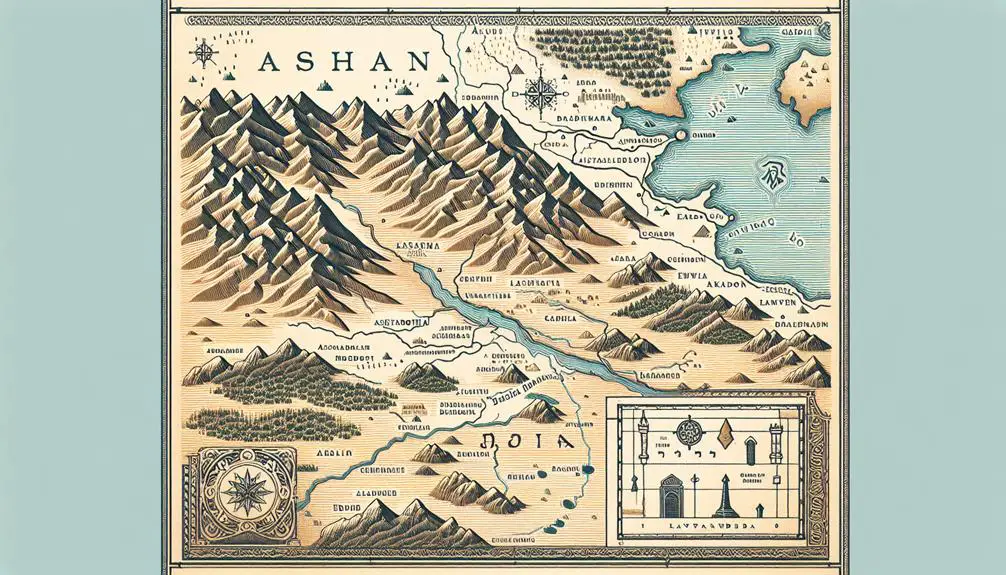
Exploring the key cities and locations within Bashan reveals a rich tapestry of historical and biblical significance. This region, nestled in the ancient Near East, wasn't just a place of abundant pastures but also a hub of civilization and trade. The ancient trade routes that traversed Bashan were arteries of commerce and cultural exchange, linking it to the wider ancient world. Archaeological discoveries in the area have unearthed remnants of these routes, showcasing Bashan's role in early trade networks. These findings provide a glimpse into the daily lives and economies of its ancient inhabitants, illuminating the region's importance beyond its agricultural wealth.
Among the key locations, the city of Ashtaroth stands out. It was once a major center, mentioned in biblical texts, serving as a testament to Bashan's historical and religious significance. Excavations in Ashtaroth have revealed structures that highlight the city's role in the region's political and economic life. Similarly, Edrei, another significant city in Bashan, offers insights into the ancient kingdom's military and strategic importance. These cities weren't only political and economic centers but also cultural and religious hubs, hosting temples and places of worship that drew people from across the region.
The exploration of Bashan's key cities and locations, through the lens of ancient trade routes and archaeological discoveries, underscores the region's multifaceted role in ancient Near Eastern history. It wasn't merely a land of fertile pastures but a pivotal area of commerce, culture, and conquest, shaping the historical narrative of the ancient world.
Modern Day Identification
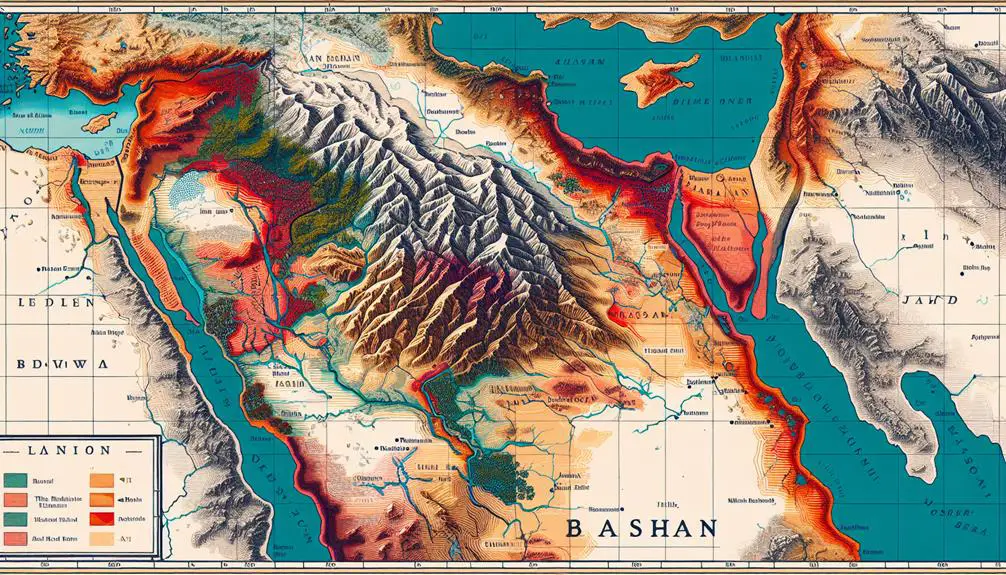
Having uncovered the historical and archaeological significance of Bashan's key cities and trade routes, it's crucial we now pinpoint the modern-day territories that correspond to this ancient region. This endeavor not only enriches our understanding of biblical narratives but also illuminates the political relevance of these areas today.
- Golan Heights: The most prominent area associated with ancient Bashan in contemporary terms is the Golan Heights. This strategically significant plateau has been the focus of extensive archaeological findings, which resonate with descriptions found in biblical texts. Its political relevance in modern conflicts and negotiations can't be overstated.
- Southern Syria: Parts of southern Syria, encompassing cities and towns that once thrived in the Bashan region, continue to reveal a wealth of archaeological insights. These findings offer a tangible link to the past, underscoring the area's long-standing cultural and political significance.
- Northern Jordan: This area is identified with the ancient region of Bashan due to its geographical proximity and historical ties. Archaeological excavations in northern Jordan have unearthed structures, artifacts, and inscriptions that corroborate biblical accounts, highlighting the enduring legacy of Bashan.
- Northeastern Israel: While the bulk of Bashan lies outside modern Israel's borders, certain northeastern areas within the country are historically connected to this ancient region. Here, archaeological efforts have also contributed to our understanding of Bashan's role in biblical times and its enduring influence.
In analyzing these territories, it's clear that the legacy of Bashan isn't confined to the past. Its archaeological treasures and political relevance continue to shape the narrative of this storied region, bridging ancient history with contemporary dynamics.
Cultural and Theological Impact
The cultural and theological impact of Bashan extends beyond its ancient ruins, shaping religious narratives and identities today. You delve into the texts, finding that Bashan's mention in sacred scriptures isn't merely historical but deeply symbolic, affecting religious interpretations and guiding faith practices across generations. It's a region imbued with profound theological significance, representing both divine bounty and judgment, which theologians and scholars dissect to understand the multifaceted nature of divine interaction with humanity.
Analyzing Bashan's depiction in religious texts reveals how its fertile lands and formidable cities have become metaphors for God's provision and protection, as well as His wrath against the wicked. This duality enriches sermons and religious discourse, offering believers a nuanced understanding of their deity's nature. You see, Bashan's narrative isn't static; it evolves with sociopolitical influences, reflecting the changing dynamics between societies and their spiritual beliefs.
In contemporary discussions, the historical and theological layers of Bashan serve as a lens through which modern believers examine their own faith. The region's storied past prompts questions about the intersection of divine promise, human action, and moral responsibility. As you navigate these complex themes, you realize Bashan's enduring relevance isn't confined to its geographic boundaries but resonates within the broader context of religious identity and cultural heritage.
The exploration of Bashan, therefore, isn't just an academic exercise but a journey into understanding how ancient narratives continue to influence modern spirituality, mediating between past and present, sacred and secular. Through this lens, you grasp the intricate ways religious interpretations and sociopolitical influences intertwine, shaping not only historical perspectives but also contemporary faith practices and identities.
Frequently Asked Questions
How Do the Flora and Fauna of Ancient Bashan Compare to Those Found in the Region Today?
You'll find that the climate impact and migration patterns have significantly altered the flora and fauna in the region once known as Bashan.
Today's biodiversity contrasts with ancient descriptions due to environmental changes and human activities.
Ancient texts depicted Bashan as rich in diverse species, but modern assessments show a shift in species composition and distribution.
These changes highlight the dynamic nature of ecosystems over time, influenced by both natural and anthropogenic factors.
Were There Any Unique Linguistic or Dialectical Features in Bashan Compared to the Rest of Ancient Israel or Surrounding Regions?
You'd find it intriguing that Bashan's language and dialects were significantly influenced by cultural exchanges, thanks to its position on ancient trade routes.
This region, unlike the rest of ancient Israel or surrounding areas, likely showcased a linguistic mosaic, blending local idioms with those of passing traders and settlers.
Analyzing these dialectical features reveals a rich tapestry of communication, underscoring Bashan's role as a crossroads of cultures and languages.
Are There Any Traditional Recipes or Foods That Originated From the Bashan Area That Are Still Made Today?
You're delving into traditional recipes from the Bashan area that have survived into modern times, reflecting significant cultural influences.
These dishes, with their unique blend of ingredients, showcase the region's rich culinary heritage.
Modern adaptations have allowed these recipes to thrive, incorporating contemporary cooking techniques while preserving their authentic flavors.
This fusion of ancient traditions and modern practices illustrates the dynamic evolution of Bashan's gastronomy, a testament to its enduring culinary legacy.
What Are Some of the Major Archaeological Discoveries in Bashan That Have Shaped Our Understanding of Its History Outside of Biblical Narratives?
In your exploration of Bashan's history, you'll find it's not just about biblical tales. Archaeologists have unearthed artifacts in the Golan Heights, revealing insights into ancient economies and societal structures.
For instance, ancient wine presses indicate a thriving wine industry, reshaping our understanding of local commerce. This discovery, among others, offers a glimpse into the daily lives and economic practices of the region's inhabitants, beyond religious texts.
How Has the Depiction of Bashan in Art and Literature Evolved From Ancient Times to the Modern Era?
The depiction of Bashan in art and literature has evolved significantly, influenced by ancient traditions and modern interpretations. Initially, artists and writers drew heavily on its biblical significance, embedding ancient influences into their works.
Over time, scholarly analysis and archaeological findings have enriched these portrayals, leading to more nuanced representations. Today, you'll find Bashan depicted with a blend of historical accuracy and creative interpretation, reflecting its complex legacy through the ages.
Conclusion
In concluding, Bashan's rich tapestry weaves through history, geography, and theology, standing as a testament to its enduring legacy in biblical lore. Nestled within its ancient borders are tales of cities, battles, and faith that have shaped its identity.
Today, identifying Bashan's modern counterpart offers a bridge between past and present, reminding us that 'history is the key to understanding the present.' Its cultural and theological impacts continue to resonate, underlining the profound depth of our shared human story.



Sign up